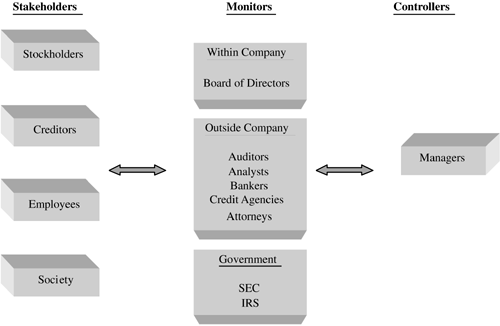Are Investors Helpless?
| In general, it is pretty safe to say that the investing public does not know what goes on at a given firm's operational level. Of course, that's why there are managers ”to handle these day-to-day operations. And, yes, it is also pretty safe to say that managers know that their behavior is mostly unknown to the investors. Therefore, the daunting question that needs to be asked is, do managers have investors right where they want them? It seems so. However, all may not be lost. There are several groups that monitor the actions of corporate management. Figure 2-1 illustrates the separation of ownership and control between stockholders and managers. In addition, the figure shows that monitors exist inside the corporate structure, outside the structure, and in government. Figure 2-1. This figure illustrates the separation of ownership and control by those groups that monitor a firm. The monitors inside the public firm are the board of directors who oversee management and are supposed to represent shareholders' interests. The board not only evaluates management, but members can also design compensation contracts to tie the salaries of management members to the firm's performance. Perhaps most importantly, the board can fire management ”even the CEO. Remember that Apple Computer was co-founded by Steve Jobs. When the firm became a public corporation, Jobs was the largest shareholder and also became CEO of the company. However, Apple's board of directors felt that Jobs was not experienced enough to steer the firm through its rapid expansion. Therefore, they hired John Sculley as CEO in 1983. However, in 1985, a power struggle ensued for control of the firm, and the board backed Sculley. In September, Jobs was kicked out of Apple. Even though Jobs was the largest shareholder in Apple and its co-founder, he no longer had a say in its business operations. He later became so disgusted with the company that he sold all his shares. Interestingly, the story has not ended for Steve Jobs. Apple Computer was having difficulties in the late 1990s, so the board hired Jobs back to be CEO. After more then ten years away from the firm, he was back. There are also outsiders who monitor a firm. Figure 2-1 shows that auditors, analysts, bankers, credit rating agencies, and outside legal counsel all interact with the firm and monitor management activities. The mission of auditors is to examine a firm's accounting systems and comment on whether financial statements are a fair representation of the financial position of the firm. Investors and other stakeholders use the public financial statements to make decisions about the firm's financial health, prospects, performance, and value. Even though investors may not have the ability or opportunity to validate the firm's activities, at least there are accountants and auditors to attest to the firm's financial health and verify its activities for them. The investment analysts who follow a firm conduct their own independent evaluations of the company's business activities. These analysts report their findings to the investment community. They are supposed to give unbiased and expert assessments. Investment banks also interact with management. They help firms access the capital markets. When obtaining more capital from public investors, firms must register documents with regulators that show the public investors the condition of the firm. Investment banks help firms with this process and advise managers on how to interact with the capital markets. The government also monitors business activities through the SEC and the Internal Revenue Service (IRS). The SEC's mission is to regulate public firms for the protection of public investors. It has the power to make policy and punish violators in civil court . However, for criminal prosecution , it must turn to the U.S. Justice Department. The IRS enforces the tax rules to ensure corporations pay taxes ”just as it ensures that individual Americans pay taxes. Taken together, this is a pretty impressive set of monitors, isn't it? So, everything is okay, right? With these many and talented monitors, it doesn't matter that ownership and control are separated, does it? Unfortunately, we have seen all of these mechanisms fail in recent times, and we are in the midst of a crisis of investor confidence. One of the main purposes of this book is to outline, in an easy-to-understand way, how these monitors have failed us and what we may be able to do about it. Part 2 examines the failure of auditors, boards , analysts, and banks. Part 3 reviews the role of regulators. |
EAN: 2147483647
Pages: 118
